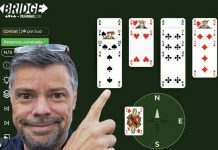The pedagogical basis of Hool
Background Bridge, as we all know, has a starting problem for beginners because of its steep learning curve. In today’s day and age with attention spans ever dwindling and app and gaming options ever increasing – spreading Bridge among kids is against the odds. Most people who play Bridge used to play some trick-taking game earlier – like Hearts, Spades, Jass, Belotte, Whist, etc. But hardly anyone young plays these games anymore, and so we have effectively lost the feeder mechanism to Bridge. Moreover, since a whole generation of Bridge players (for whatever reason) didn’t pass on Bridge to their kids – the second feeder mechanism of ‘home osmosis’ doesn’t exist as well. So MiniBridge was developed as the new feeder mechanism. But the problem with MiniBridge, for me, is that it is just not a complete gaming experience – both for teachers as well as for students. Rather, MiniBridge is a transitory game, something that must be taught (to enable the student to understand the fundamentals of card play) before moving on to the full game of Bridge. Since Bridge teachers themselves do not find MiniBridge engaging as a game, there is a tendency to get over this stage sooner. Besides, the gap between MiniBridge and Bridge is big and often many students are lost in the transition. Creating Hool App + Board game: Apps are the obvious trend today, but so are Board games. I wanted Hool to be in both formats to appeal to a wider audience. App-based games are usually fast paced and likewise is the Hool App. For example, when you click on the button for Hand Pattern, the app displays it immediately. On the other hand, the Board game experience is necessarily slow; likewise a player will need time to first see the Hand Pattern, find the 4 cards that fits this Hand Pattern, then has to insert them into the card holder and then turn it around to finish his/her turn. Complete gaming experience: The idea was to create a game that would capture the essence of Bridge – that of bidding, partnership understanding, visualization and inferential cardplay. A game that was easy enough to learn the mechanics of the play (more or less) on one’s own but difficult to master – how modern gaming or chess is. The app version actually has 3 games – first version is for two players, second is for three players and the third version is full game of Hool for four players. In the two-player version, player A plays for N-S (seeing 26 cards) while player B plays for E-W (seeing the other 26 cards). Both make a bid each and the highest bid wins. In the three-player version, the dummy is laid out while players A B and C try to make the maximum bid win to win the dummy and be the declarer. I feel these two versions lead organically into the full game of Hool for four players. For absolute beginners who don’t know what is a trick, trump, etc – I have developed an app called Kida that can be (freely) downloaded: Click here. Interesting game even for Bridge players: I feel that Bridge teachers would put a lot more creativity and passion into their teaching if the material posed enough intrigue for them. Also, there would be no need to hurry up with Hool and get on with Bridge, since Hool already echoes the different aspects of Bridge. Moreover, Bridge players who would normally have dismissed Bridge teaching for beginners as ‘impossibly difficult’ or ‘don’t know where to start’ would hopefully look upon teaching Hool as something they might try. Bridge Kids playing Hool with non-Bridge playing friends: Bridge teachers are in short supply. To effectively spread Bridge we have to get young players in schools and universities to teach their friends – and Hool can be an effective tool to facilitate that. Reaching the non-bridge audience directly: If Hool somehow became a game that appealed to the youth, then surely the better players of Hool would sooner or later gravitate towards Bridge. To give an example from another sport – Cricket, a British game played in countries they colonized (India, Australia, South Africa, Caribbean, etc) was dying some years ago in its original form known as ‘Test Cricket’. That’s when cricket re-invented itself via another format – ‘Twenty20’ – a concise exciting modern version that drove the crowds back into the stadiums worldwide. In fact in addition to its returning fans, cricket found a totally new audience in women. But all cricketers and knowledgeable fans know that Test Cricket is the highest form of the game. So the better cricketers always aspire to play and excel in Test Cricket knowing that no other form of cricket ‘tests’ their skills in such depth as the traditional form. Thus the modern Twenty20 format has become the feeder game for traditional Test Cricket. Likewise, it is hoped that Hool becomes the feeder game for BridgeWhat is World Bridge Youth News?

Hi…I am Gilad Ofir, WBF: Youth Bridge Development Coordinator
World Bridge Youth News is your bridge on-line newspaper: bridge news, bridge entertainment, bridge videos, bridge photos, bridge articles, bridge tournaments, etc.
World Bridge Youth News will provide you with the latest breaking news, tournaments results, photos and videos straight from all the most important Bridge Youth activity worldwide.
You can contact me via:
Facebook: Click Here
Instagram: Click Here
Via email: Gilad.ofir@worldbridgefed.com
We are willing to know about you…Send us your ideas, your comments…Help us to make grow bridge all around the planet…





























